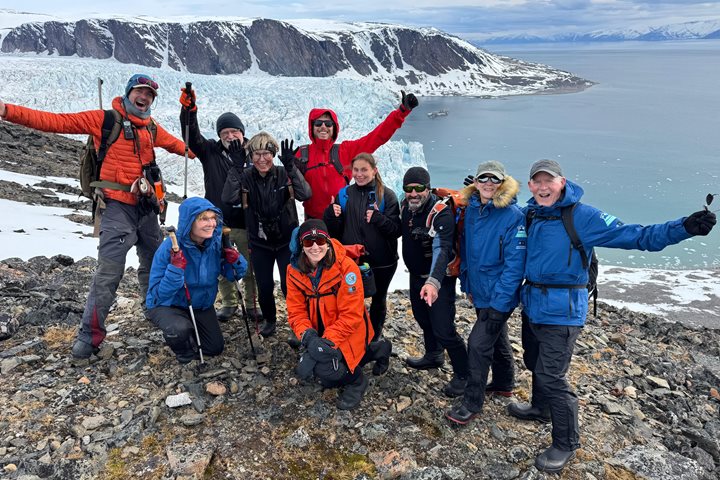Our morning began not terribly far from where we concluded yesterday—cruising the remnant fast and sea ice around Wilhelmøya searching for wildlife. Our persistence paid off by spotting three more polar bears roaming the expanse of fast ice in search of seals. Though quite distant the privilege of observing these magnificent animals at any range added a great deal to our appreciation of their roles here in the Arctic. Our intent for the remainder of the morning was to seek out even more remnant sea ice in Bjornsundet (Bear Sound) in hopes of encountering more wildlife. All along the edge of the sea ice hordes of Brünnich's Guillgemots, kittiwakes, and other seabirds foraged for small fishes and invertebrates. Harp and bearded seals as well as walrus lay about on the fast ice, resting and molting in the Arctic sun, and their nemesis the polar bear was present as well. In this environment bears have a difficult time hunting seals due to the flat nature of the shore fast ice, void of nearly any features for them to hide behind. Nevertheless they can still manage to occasionally capture prey through persistence and good luck. By the time the morning was concluded we had added eight more bears to our tally including one male bear walking the ice edge right in front of the ship as we lay parked in the ice. Lastly we spotted a female bear and its cub of the year strolling along the distant shore, a reminder that not only is the remnant ice of winter fading but the bears too are clinging to the remains of this habitat. All totaled we encountered and observed 23 polar bears over 36 hours, all of whom were located on a rather narrow strip of sea ice that will surely not remain for too long, leaving these bears little options to find suitable habitat. More important than the number of bears seen is the overall appreciation for the beauty and fragile ruggedness of this part of the Arctic, so removed but yet connected to all the world in many ways.
Having left the sea ice behind for the time we pressed north and east towards Wahelnbergfjorden via Hinlopen Strait, the passage lying between Eastern Spitsbergen and Nordaustlandet, the second largest island in the archipelago. Here in Eastern Svalbard the world looks quite different than where we began our expedition. Lying in the lee of the prevailing weather patterns this landscape sees even less precipitation creating what can only be called an Arctic desert. The geology too is quite distinct here as well with massive butte-like peaks of sandstone topped in basalt-looking rock as if they were cleaved off. To get a better sense of what this world looks and feels like we chose a landing site in Palanderbukta, a fjord off the main arm of Wahlenbergfjorden. Setting out for an afternoon of exploration here provided us a wonderful opportunity to experience one of the starkest, harsh, and truly beautiful settings anywhere. Upon a cursory look it appears as if nothing could live here, but only a few minutes of investigation reveals the delicate beauty of such a place. Gradual slopes of multicolored mixed stones rise up from the shore, elegant cryptographic soils caught one’s eye as we made our way over the raised terraces of ancient beaches once crushed under thousands of feet of glacial ice. Signs of Svalbard reindeer were everywhere, eider ducks, arctic skuas, and fulmars cruised the shoreline. One of our hiking groups even came across a polar bear carcass crushed to death in a winter avalanche, a rare opportunity to get a firsthand look at this magnificent animal.
Lastly, to conclude our day we visited one of the more vibrant and bustling sights in all of Svalbard, the bird cliffs of Alkefjellet. This impressive slab of stone towers out of the sea and provides prime nesting habitat for Brünnich's guillemots, kittiwakes, and glaucous gulls. Numbering in the tens of thousands of pairs the activity around this sight is spellbinding, and for an after-dinner conclusion to our day a real show stopper. A few arctic foxes frantically searched the area below the cliffs for vulnerable prey.






